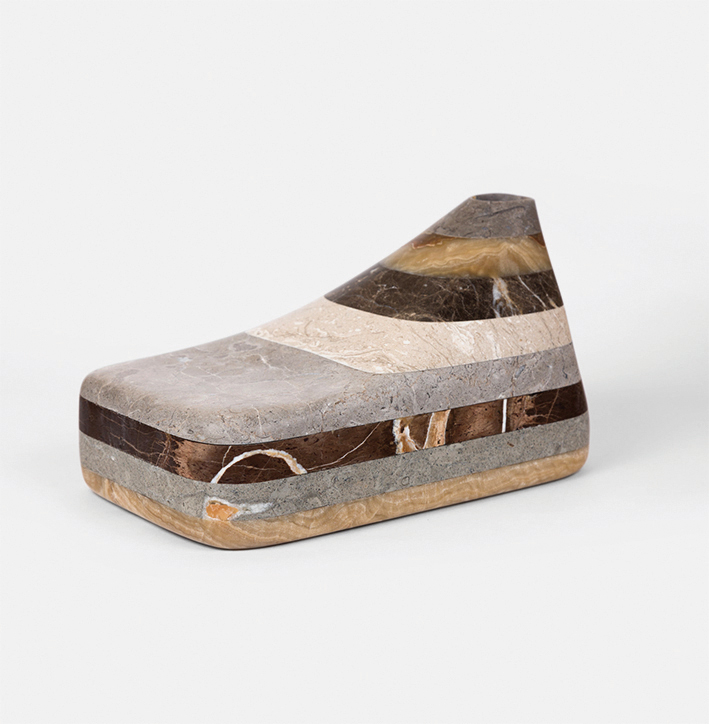A new sculpting medium–Kutleh
by Purva Chawla
We are tremendously fascinated today with offcuts and excess.
Offcuts being the remainder of beautiful and valuable materials, created by slicing and trimming to a precise dimension or shape, and excess being the well-made finished products whose demand has failed to match their supply.
A chief attraction for those in the design and manufacture industries is the possibility of converting these often discarded ‘secondary’ or surplus elements, into something primary and valued in its own right. From timber to leather, and metals to natural stone–offcuts from machining and fabrication for design are taking center stage; and their aesthetic, functional strengths and narrative are being revealed.
Last month, at Milan Design Week, I had the opportunity to immerse myself, quite literally, in this idea. At the Salone Satellite, I was delighted to sit and lean into a magnificent and monolithic chair, a throne of sorts, composed of what felt like 50 layers of rich and diverse stone. The multi-hued chair, it turns out, was carved from a new kind of stone block and is the result of a project called Kutleh.
Kutleh Chair–This hyperbolic prototype, inspired by the concrete experiments of Roni Horn’s chair, is the first adaptation of Kutleh, as it explores the wild and boundless possibilities of this material.
The layering of stone surplus, seen in the Kutleh Chair
Led by Architect Rula Yaghmour and Jordan-based stone fabricators A.W Yasin & Sons Co, Kutleh– meaning block or mass in Arabic–unites surplus material from the production of stone cladding tiles, and transforms it into new blocks. More than a simple aggregation of mass, these blocks are a unique and curated medium composed of selective color spectra that evoke the natural stones in the Levant and the Mediterranean.
Among the project's outcomes is the large chair I sat on, an extensive series of vases and a set of light fixtures–all of which express the versatility and potential of this new medium. Also highlighted, through union and juxtaposition, are the many natural stones of the region. The real win, however, isn’t the beauty of these sculpture objects. Instead, it is Kutleh’s offering of a new material altogether, for artists, sculptors, and designers to work with as they please.
Kutleh presents itself as a redefined raw material, one which designers can carve out their limitless creations from, and use to introduce innovative new forms.
Kutleh, Series 02, Vase
Kutleh, Series 01, Lamp
While it is vital for Kutleh to reflect the local feel of the region where it has been created till now–the Levant– its creators think of the project as one that extends far beyond these boundaries. Stone waste is produced all over the world, and the project can evolve to producing localized collections that reflect different regions and their raw materials.
On the subject of stone waste, Kutleh’s core role is no doubt in creating value and functionality from waste, and to some extent in creating awareness about this surplus itself. There is waste generated at every stage in the stone quarrying, machining and application process, and manufacturers and designers are continually seeking new ways of utilizing it.
For centuries now, at the quarrying stage, smaller discarded chunks of natural stone have been used for construction aggregate, rip-rap or gravel. In recent years there have been efforts to consume and employ even finer stone dust in the making of cement, instead of silica an idea that has gained traction as river sand is being depleted. Suppliers of dimension stone and fabricators of stone slabs intended for construction use have sold their project offcuts and miscellaneous bits at heavily discounted prices, simply to get rid of excess materials.
Kutleh, Series 02, Vase
The layering of stone surplus, seen in the Kutleh Chair
In this context, Kutleh stands out–not only because it deals with the issue of surplus and waste in stone tile-material, but for presenting a design solution that can be clearly perceived by a user/buyer as being more valuable than the uncut original sheet materials themselves. The project isn’t about hastily repurposing a waste-stream, it's about inventing a sought-after, almost precious new material–a clean slate.
The project has so far resulted in several distinct types of blocks, each one a theme in itself really. They include:
- Origin / Eclectic block: A reflection of the project's origins, each block carries all the shades and stone colors of the Mediterranean, with randomly-arranged layers for distinctive personalities.
- Petra / Reds block: The manifestation of a world wonder, Petra embodies the marvelous hues of red in an arrangement that echoes the majestic colors of the Nabataean mountains.
- Quds / Natural block: A delicate low-contrast mass from world-renowned Jerusalem natural stone forms interwoven shades of white and beige.
Along with three other distinct hues and compositions of stone. To learn more about Kutleh, and working with these new material medium, visit the project's website here.
Kutleh at Salone del Mobile 2018














